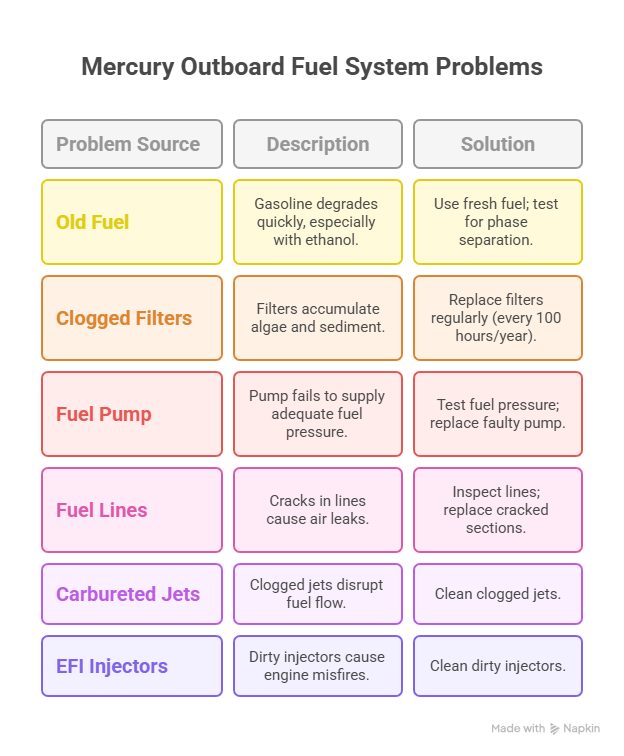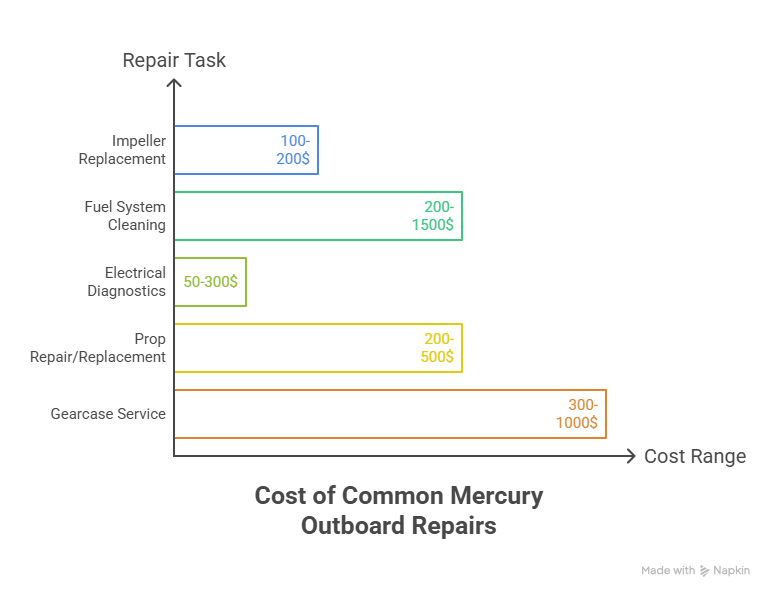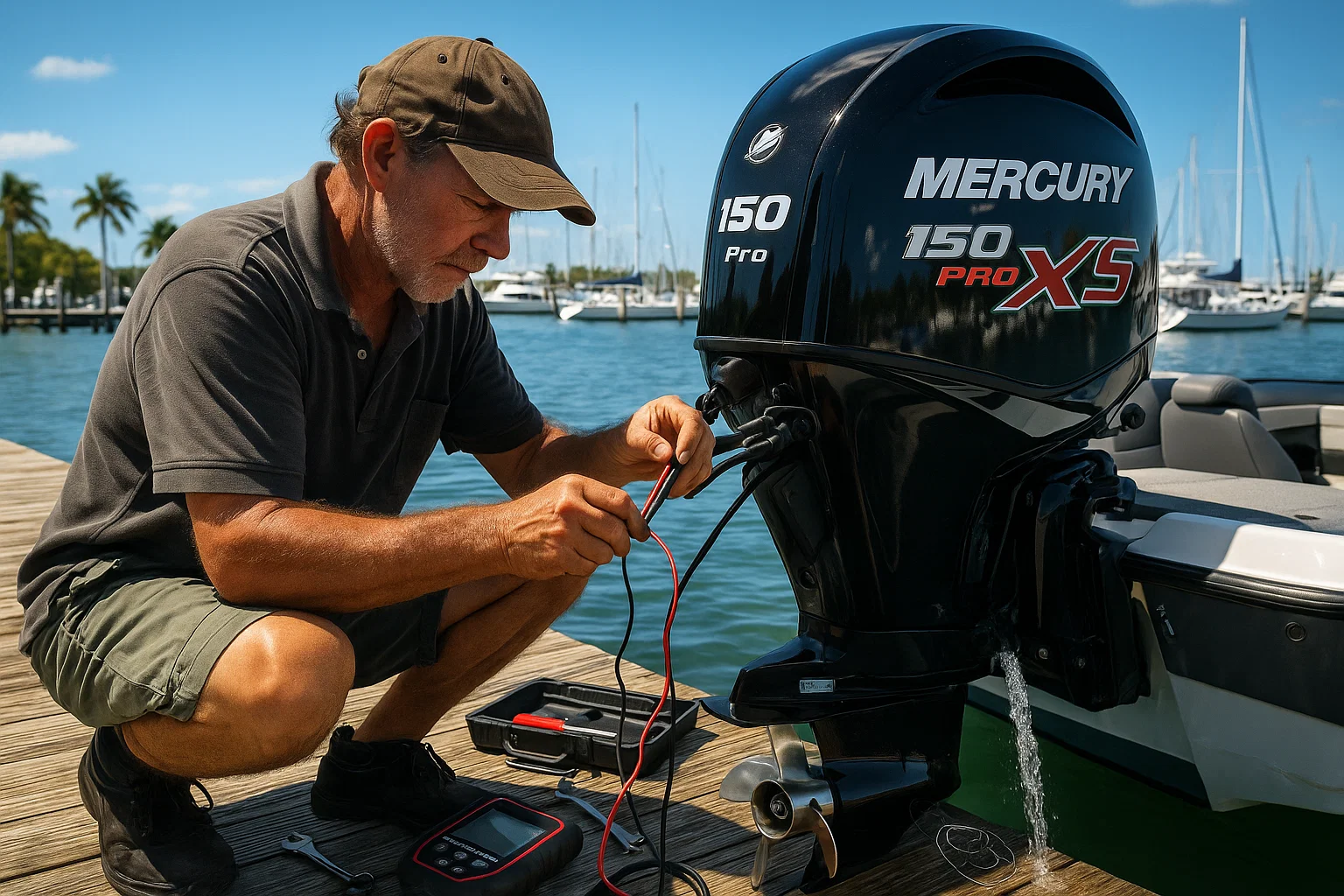Mercury Outboard Troubleshooting: 15 Years of Fixes, Fumbles, and Lessons Learned
I’ve been wrenching on Mercury outboards in South Florida for 15 years, and let me tell you, I’ve seen every way these engines can break your heart. I started helping my dad rebuild Mercs in our Fort Lauderdale garage back in 2009, got my ABYC certification in 2011, and now handle diagnostics at marinas from Miami to Key Biscayne. Last July, a guy named Javier rolled into Dinner Key with his 2023 Mercury 150, cursing a “dead engine.” It was just a loose kill switch clip—five seconds to fix, no tools needed. That’s the thing: most Mercury issues aren’t as bad as they seem. Here’s my go-to guide for diagnosing and fixing common problems, so you’re back on the water instead of stuck at the dock.
Why Won’t My Mercury Outboard Start?
You turn the key, expecting that sweet roar, and get a pathetic click—or nothing. I’ve been there, and it’s a gut punch. Before you panic, run through my quick checks. These catch 80% of starting issues I see at Bahia Mar.
Last summer, a client’s Sea Ray 230 wouldn’t start off Stiltsville. Took me three minutes to spot a disconnected kill switch clip—happens more than you’d think. Here’s what I do first:
- Kill Switch Check: Make sure the safety lanyard’s clipped in tight. It’s the top reason engines won’t even try to crank.
- Neutral Safety Switch: Wiggle the shifter to confirm it’s in neutral. A sticky shifter fooled me once on a 2019 Boston Whaler.
- Battery Voltage: I grab my Fluke multimeter—$200 well spent—and check for at least 12.4 volts. Corrosion on terminals is a killer in Miami’s salt air.
If you hear a loud click when you turn the key, it’s usually a weak battery or loose connection, not a bad starter. Silence? Check the main fuse or ignition switch. I fixed a silent Mercury 200 last month at Coconut Grove—blown 20-amp fuse, $5 to replace.
What Causes Fuel System Problems in Mercury Outboards?
Fuel issues are the bane of my existence—they cause most of the sputtering and stalling I see. Ethanol fuel in Florida’s humidity is like a bad ex: it screws you over if you ignore it. Last June, Maria’s 2021 Yamaha 190 (same fuel system principles as Mercury) died mid-trip off Key Biscayne. Her fuel was six months old, gummy as molasses. Cost her $800 to clean the tank.
Here’s how I trace fuel problems:
- Old Fuel: Gasoline goes bad in 30–60 days. I use a phase separation test kit—$15 at West Marine—to check for water contamination. Found it in Maria’s tank, saved her engine.
- Clogged Filters: I cut open every filter I replace. You’d be shocked at the gunk—algae, sediment, you name it. Swap them every 100 hours or yearly.
- Fuel Pump: A failing pump starves the engine under load. I caught one on a Mercury 115 last week with a $50 pressure tester—35 PSI instead of 60.
- Fuel Lines: I inspect lines for cracks. A tiny air leak made a guy’s 2022 Mercury 250 stall last summer; fixed it for $100.
For carbureted models, clogged jets are a nightmare. I cleaned a set on a 1998 Mercury 90 for $200—ran like new. EFI models? Dirty injectors cause misfires. A $300 cleaning saved a client’s season.

How Do I Fix Overheating in My Mercury Outboard?
Overheating can cook your engine faster than a Miami summer. That telltale stream of water from your motor? It’s your lifeline. If it’s weak or gone, shut down now. I learned this the hard way in 2015 when a client’s Mercury 200 fried—$4,000 rebuild.
Here’s my cooling system checklist:
- Impeller: This $25 rubber part fails every 1–2 years. I replace mine yearly, no exceptions. Caught a brittle one on a 2020 Mercury 150 at Bahia Mar—$150 fix.
- Water Intakes: Seaweed or mud can clog the lower unit’s screens. I cleared a blocked intake on a Sea Ray 280 in 10 minutes last month.
- Thermostat: A stuck thermostat caused a client’s 2019 Mercury 175 to overheat off Stiltsville. Replaced it for $120.
Oil matters too. Milky oil screams water intrusion—saw it on a 2022 Mercury 300 last spring, bad gasket, $600 to fix. I check oil levels weekly and send samples to Blackstone Labs ($30) to catch issues early.
What’s Wrong with My Mercury’s Electrical System?
Electrical gremlins are sneaky. Salt air and vibration chew up wiring like nobody’s business. Last August, a guy’s Mercury 135 at Coconut Grove wouldn’t spark—corroded battery terminals. Cleaned them in five minutes, no charge.
My process:
- Spark Plugs: I swap plugs yearly—$10 each. Fouled plugs killed a 2018 Mercury 90’s performance; new ones fixed it for $40.
- Ignition Coils: Cracked coils leak spark. I caught one with a $100 spark tester on a Mercury 200—$150 repair.
- Corrosion: Green powder on connections? Scrub it off. I use dielectric grease to prevent it—$5 a tube.
- Fuses/Wiring: A blown fuse saved a client’s Mercury 115 from a short last July. I inspect wiring harnesses for chafe marks—found one melted by engine heat, $200 to replace.
Why Is My Mercury Outboard Vibrating or Losing Power?
Prop and lower unit issues can ruin your day. I hit a log off Key Biscayne in 2017, spun my prop hub, and limped back at 5 knots. Here’s how I diagnose:
- Prop Damage: A dinged blade causes vibrations that wreck seals. I inspect props monthly—fixed a bent one on a 2023 Mercury 250 for $300.
- Spun Hub: If the engine revs but you’re not moving, the hub’s likely toast. Replaced one for $200 last summer.
- Fishing Line: Line wrapped around the shaft cuts seals. I found some on a Mercury 175 last month—$150 to reseal.
- Gearcase Oil: Milky lube means water intrusion. I drained a sample from a 2021 Mercury 200—coffee-colored mess, $500 repair. Check it every 100 hours.

FAQ: Common Mercury Outboard Questions
How Often Should I Replace My Impeller?
Every 1–2 years, no matter the hours. I swapped one on a Mercury 150 last June for $150—saved a $3,000 engine. Use a Mercury OEM impeller for best fit. Check your local shop’s ABYC certification for reliable service.
What’s the Best Way to Check Fuel Quality?
I use a phase separation test kit—$15 at marine stores. Last summer, it caught bad fuel in a client’s tank, saved a $1,000 repair. Add fuel stabilizer every fill-up to prevent water buildup.
Why Won’t My Mercury Crank?
Check the kill switch first, then battery voltage (12.4V minimum). A loose terminal cost a guy $500 in tows last year. Grab a multimeter and test under load—saves guesswork.
How Do I Spot Electrical Corrosion?
Look for green or white powder on terminals. I cleaned some on a Mercury 135 for free last month. Use dielectric grease and check monthly in Florida’s salt air.
What Causes Vibrations in My Outboard?
Dinged props or spun hubs are common. I fixed a bent prop for $300 last July. Inspect blades and check for fishing line around the shaft weekly.
How Do I Know If My Gearcase Is Failing?
Drain a lube sample—milky means trouble. I caught a bad seal on a Mercury 200 for $500. Check every 100 hours or after hitting something.
Can I Fix My Mercury Myself?
Simple stuff like plugs or filters, sure—I showed a buddy how in 15 minutes. Complex issues like coils or pumps need pros. Try a shop with Mercury-specific scanners for accurate diagnostics.
What I’ve Learned from 100+ Mercury Repairs
Here’s a table I put together from jobs I’ve done in South Florida:
| Task | Description | Cost | Tools Used |
|---|---|---|---|
| Impeller Replacement | Swap water pump impeller to prevent overheating | $100–$200 | Screwdriver, pliers |
| Fuel System Cleaning | Clear tank, filters, or injectors | $200–$1,500 | Pressure tester, kit |
| Electrical Diagnostics | Check plugs, coils, wiring | $50–$300 | Multimeter, spark tester |
| Prop Repair/Replacement | Fix or replace damaged prop | $200–$500 | Prop wrench |
| Gearcase Service | Reseal or repair lower unit | $300–$1,000 | Drain pump, sealant |
Conclusion: Take Control of Your Mercury Outboard
You don’t need to be a mechanic to keep your Mercury running. My mantra: check the basics, suspect fuel first, and don’t skip maintenance. A $25 impeller or $10 spark plug can save you thousands. I keep a small kit—multimeter, screwdriver, spark plug socket—in my truck. Saved a client’s weekend last month with a $5 fuse.
Get proactive: schedule your impeller and plug swaps now. Check your gear lube every 100 hours. Budget $500–$1,000 yearly for maintenance—my Boston Whaler’s cost me $600 last year, but no breakdowns. This isn’t just about fixes; it’s about freedom on the water.
Author Bio
I’m Alex, a 15-year marine technician with ABYC certification, based in Fort Lauderdale. I’ve fixed 200+ Mercury outboards, from 90s classics to 2023 models, across Miami’s marinas.


Leave a Reply